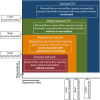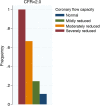Coronary flow capacity: concept, promises, and challenges
- PMID: 28353034
- PMCID: PMC5489577
- DOI: 10.1007/s10554-017-1125-z
Coronary flow capacity: concept, promises, and challenges
Abstract
The vasodilator capacity of the coronary circulation is an important diagnostic and prognostic characteristic, and its accurate assessment is therefore an important frontier. The coronary flow capacity (CFC) concept was introduced to overcome the limitations associated with the use of coronary flow reserve (CFR) for this purpose, which are related to the sensitivity of CFR to physiological alterations in systemic and coronary hemodynamics. CFC was developed from positron emission tomography, and was subsequently extrapolated to invasive coronary physiology. These studies suggest that CFC is a robust framework for the identification of clinically relevant coronary flow abnormalities, and improves identification of patients at risk for adverse events over the use of CFR alone. This Review will discuss the concept of CFC, its promises in the setting of ischaemic heart disease, and its challenges both in theoretical and practical terms.
Keywords: Coronary flow; Coronary flow capacity; Coronary flow reserve; Vasodilator reserve capacity.
Conflict of interest statement
Conflict of interest
TPH, ME, JE, and JJP have served as speakers at educational events organized by St Jude Medical, Boston Scientific, and/or Philips-Volcano, manufacturers of sensor-equipped guidewires.
Ethical approval
This article does not contain any studies with human participants performed by any of the authors.
Figures




Similar articles
-
Diagnostic and Prognostic Implications of Coronary Flow Capacity: A Comprehensive Cross-Modality Physiological Concept in Ischemic Heart Disease.JACC Cardiovasc Interv. 2015 Nov;8(13):1670-80. doi: 10.1016/j.jcin.2015.05.032. JACC Cardiovasc Interv. 2015. PMID: 26585617
-
Assessment of left anterior descending artery stenosis of intermediate severity by fractional flow reserve, instantaneous wave-free ratio, and non-invasive coronary flow reserve.Int J Cardiovasc Imaging. 2017 Jul;33(7):999-1007. doi: 10.1007/s10554-016-1000-3. Epub 2016 Oct 17. Int J Cardiovasc Imaging. 2017. PMID: 27752796
-
Diagnostic and Prognostic Efficacy of Coronary Flow Capacity Obtained Using Pressure-Temperature Sensor-Tipped Wire-Derived Physiological Indices.JACC Cardiovasc Interv. 2018 Apr 23;11(8):728-737. doi: 10.1016/j.jcin.2018.01.249. Epub 2018 Mar 28. JACC Cardiovasc Interv. 2018. PMID: 29605243
-
Diagnostic accuracy of stress myocardial perfusion imaging compared to invasive coronary angiography with fractional flow reserve meta-analysis.Circ Cardiovasc Imaging. 2015 Jan;8(1):e002666. doi: 10.1161/CIRCIMAGING.114.002666. Circ Cardiovasc Imaging. 2015. PMID: 25596143 Review.
-
Invasive coronary physiology for assessing intermediate lesions.Circ Cardiovasc Interv. 2015 Feb;8(2):e001942. doi: 10.1161/CIRCINTERVENTIONS.114.001942. Circ Cardiovasc Interv. 2015. PMID: 25657316 Review. No abstract available.
Cited by
-
Microvascular dysfunction following deferred stenting strategy in ST-segment elevation myocardial infarction: a case report.Eur Heart J Case Rep. 2023 Nov 14;7(11):ytad564. doi: 10.1093/ehjcr/ytad564. eCollection 2023 Nov. Eur Heart J Case Rep. 2023. PMID: 38034941 Free PMC article.
-
Impact of clinical and haemodynamic factors on coronary flow reserve and invasive coronary flow capacity in non-obstructed coronary arteries: a patient-level pooled analysis of the DEBATE and ILIAS studies.EuroIntervention. 2021 Apr 2;16(18):e1503-e1510. doi: 10.4244/EIJ-D-19-00774. EuroIntervention. 2021. PMID: 31951205 Free PMC article.
-
Whence we came, whither we go?Int J Cardiovasc Imaging. 2017 Jul;33(7):957-959. doi: 10.1007/s10554-017-1166-3. Int J Cardiovasc Imaging. 2017. PMID: 28623495 No abstract available.
-
Cardiovascular imaging 2017 in the International Journal of Cardiovascular Imaging.Int J Cardiovasc Imaging. 2018 Jun;34(6):833-848. doi: 10.1007/s10554-018-1349-6. Int J Cardiovasc Imaging. 2018. PMID: 29651658 No abstract available.
-
The Evaluation of Left Ventricle Ischemic Extent in Patients with Significantly Suspicious Cardiovascular Disease by 99mTc-Sestamibi Dynamic SPECT/CT and Myocardial Perfusion Imaging: A Head-to-Head Comparison.Diagnostics (Basel). 2021 Jun 16;11(6):1101. doi: 10.3390/diagnostics11061101. Diagnostics (Basel). 2021. PMID: 34208558 Free PMC article.
References
-
- Taqueti VR, Hachamovitch R, Murthy VL, et al. Global coronary flow reserve is associated with adverse cardiovascular events independently of luminal angiographic severity and modifies the effect of early revascularization. Circulation. 2015;131:19–27. doi: 10.1161/CIRCULATIONAHA.114.011939. - DOI - PMC - PubMed
Publication types
MeSH terms
LinkOut - more resources
Full Text Sources
Other Literature Sources
Medical

